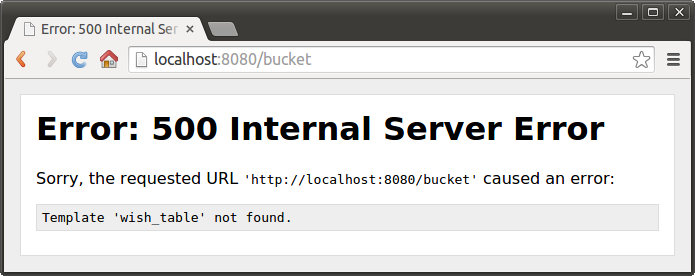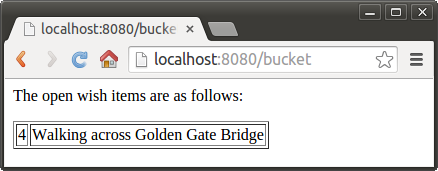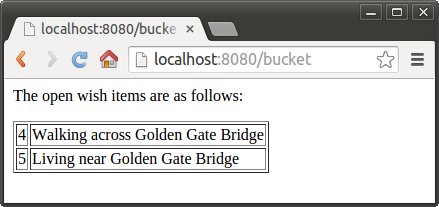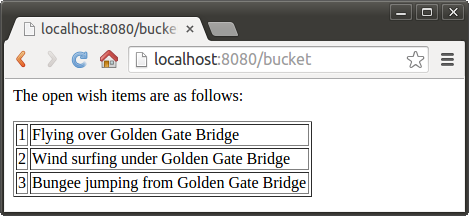Bottle micro web services framework 5 : Bucket List App I - sqlite, route, and template

List of Bottle Micro Web Services Tutorials
- Introduction
- Static files
- Template
- json
- Bucket List App I - sqlite, route, and template
- Bucket List App II - get & post
- Bucket List App III - Editing
- Bucket List App IV - route validation, regex, and static_file
- Bucket List App V - json
- json to html table
- Forms - Get & Post
- Forms - Get & Post with editable and checkbox table cells
In this chapter, we'll cover some of the key features of Bottle framework via a Buck list app. This tutorial is based on Tutorial: Todo-List Application, and I'll try to give more code samples by making variations on the ToDo List.
First, we need to make a db using SQLite:
sq.py:
import sqlite3
con = sqlite3.connect('bucket.db')
con.execute("CREATE TABLE bucket (id INTEGER PRIMARY KEY, wish char(100) NOT NULL, status bool NOT NULL)")
con.execute("INSERT INTO bucket (wish,status) VALUES ('Flying over Golden Gate Bridge',0)")
con.execute("INSERT INTO bucket (wish,status) VALUES ('Wind surfing under Golden Gate Bridge',0)")
con.execute("INSERT INTO bucket (wish,status) VALUES ('Bungee jumping from Golden Gate Bridge',0)")
con.execute("INSERT INTO bucket (wish,status) VALUES ('Walking across Golden Gate Bridge',1)")
con.commit()
Run the server:
$ python bjson.py Bottle v0.12.7 server starting up (using WSGIRefServer())... Listening on http://localhost:8080/ Hit Ctrl-C to quit. 127.0.0.1 - - [06/Oct/2014 20:08:03] "GET /api/status HTTP/1.1" 200 53
This will generates a database-file bucket.db with tables called bucket and three columns id, wish, and status. id is a unique id for each row, which is used later on to reference the rows. The column wish holds the text which describes the wish, it can be max 100 characters long. Finally, the column status is used to mark a task as open (value 1) or closed (value 0).
Then we have db created:
$ ls bucket.db sq.py
When the page http://localhost:8080/bucket is used as the url for the browser, Bottle takes the call and checks if there is any (Python) function defined for the route 'bucket'. If so, Bottle will execute the corresponding Python code and return its result.
bucket.py:
import sqlite3
from bottle import route, run
@route('/bucket')
def bucket_list():
conn = sqlite3.connect('bucket.db')
c = conn.cursor()
c.execute("SELECT id, wish FROM bucket WHERE status LIKE '1'")
result = c.fetchall()
return str(result)
run()
The run() starts the web server included in Bottle. By default, the web server serves the pages on 'localhost' and 'port 8080'. The imported route is responsible for Bottle's routing. Note that we defined one function, bucket_list(), with a few lines of code reading from the database. The important point is the decorator statement @route('/bucket') right before the def bucket_list() statement. By doing this, we bind this function to the route /bucket, so every time the browsers calls http://localhost:8080/bucket, Bottle returns the result of the function bucket_list(). That is how routing within bottle works.
Let's just run python bucket.py and call the page http://localhost:8080/bucket in our browser:

What we see is a list of tuples with each tuple contains one set of results returned from the SQL query.
Actually, we can bind more than one route to a function. So the following code will work:
@route('/bucket')
@route('/my_bucket')
def bucket_list():
...
However, it won't work if we bind one route to more than one function.
Another feature is auto-reloading, which is enabled by modifying the run() statement like this:
run(reloader=True)
This will automatically detect changes to the script and reload the new version once it is called again, without the need to stop and start the server.
A template in bottle is stored as separate file with a .tpl extension. The template can be called from within a function. Template can contain any type of text (which will be most likely HTML mixed with Python statements). Furthermore, templates can take arguments, e.g. the result set of a database query, which will be then formatted within the template.
In this section, we are going to put the result of our query showing the open bucket list items into a simple table with two columns: the first column will contain the id of the item, the second column the list. The result set is, as we've seen in the previous picture, a list of tuples, each tuple contains one set of results.
To incorporate the template in our example, we just add the following lines:
# bucket.py
import sqlite3
from bottle import route, run, template
HOST = 'localhost'
PORT = 8080
@route('/bucket')
def bucket_list():
conn = sqlite3.connect('bucket.db')
c = conn.cursor()
c.execute("SELECT id, wish FROM bucket WHERE status LIKE '1'")
result = c.fetchall()
c.close()
return template('wish_table', rows=result)
run(host=HOST, port=PORT, debug=True)
Two new things here:
- We imported template from Bottle.
- We returned the output of the template wish_table. In addition to calling the template, we assign result, which we received from the database query, to the variable rows, which is later on used within the template.
Note that templates always return a list of strings, thus there is no need to convert anything.
If we run the server at this stage and calls http://localhost:8080/bucket, we get the following error:

So, we need to write the wish_table.tpl template, which should like this:
%# wish_table.tpl
<p>The open wish items are as follows:</p>
<table border="1">
%for r in rows:
<tr>
%for c in r:
<td>{{c}}</td>
%end
</tr>
%end
</table>
The line starting with % is interpreted as Python code. Please note that, of course, only valid Python statements are allowed, otherwise the template will raise an exception. The other lines are plain HTML.
As we can see, we use Python's for statement two times, in order to iterate over rows. The rows is a variable which holds the result of the database query, so it is a list of tuples. The first for statement accesses the tuples within the list, the second one the items within the tuple, which are put each into a cell of the table.
If we need to access a variable within a non-Python code line inside the template, we need to put it into double curly braces. This tells the template to insert the actual value of the variable right in place.

Since we only have one item, let's add one more by running the following script (sq2.py):
import sqlite3
con = sqlite3.connect('bucket.db')
with con:
cur = con.cursor()
con.execute("INSERT INTO bucket (wish,status) VALUES ('Living near Golden Gate Bridge',1)")
con.commit()

Of course, we can have more items if we select '0' in bucket.py file:
c.execute("SELECT id, wish FROM bucket WHERE status LIKE '0'")

Python tutorial
Python Home
Introduction
Running Python Programs (os, sys, import)
Modules and IDLE (Import, Reload, exec)
Object Types - Numbers, Strings, and None
Strings - Escape Sequence, Raw String, and Slicing
Strings - Methods
Formatting Strings - expressions and method calls
Files and os.path
Traversing directories recursively
Subprocess Module
Regular Expressions with Python
Regular Expressions Cheat Sheet
Object Types - Lists
Object Types - Dictionaries and Tuples
Functions def, *args, **kargs
Functions lambda
Built-in Functions
map, filter, and reduce
Decorators
List Comprehension
Sets (union/intersection) and itertools - Jaccard coefficient and shingling to check plagiarism
Hashing (Hash tables and hashlib)
Dictionary Comprehension with zip
The yield keyword
Generator Functions and Expressions
generator.send() method
Iterators
Classes and Instances (__init__, __call__, etc.)
if__name__ == '__main__'
argparse
Exceptions
@static method vs class method
Private attributes and private methods
bits, bytes, bitstring, and constBitStream
json.dump(s) and json.load(s)
Python Object Serialization - pickle and json
Python Object Serialization - yaml and json
Priority queue and heap queue data structure
Graph data structure
Dijkstra's shortest path algorithm
Prim's spanning tree algorithm
Closure
Functional programming in Python
Remote running a local file using ssh
SQLite 3 - A. Connecting to DB, create/drop table, and insert data into a table
SQLite 3 - B. Selecting, updating and deleting data
MongoDB with PyMongo I - Installing MongoDB ...
Python HTTP Web Services - urllib, httplib2
Web scraping with Selenium for checking domain availability
REST API : Http Requests for Humans with Flask
Blog app with Tornado
Multithreading ...
Python Network Programming I - Basic Server / Client : A Basics
Python Network Programming I - Basic Server / Client : B File Transfer
Python Network Programming II - Chat Server / Client
Python Network Programming III - Echo Server using socketserver network framework
Python Network Programming IV - Asynchronous Request Handling : ThreadingMixIn and ForkingMixIn
Python Coding Questions I
Python Coding Questions II
Python Coding Questions III
Python Coding Questions IV
Python Coding Questions V
Python Coding Questions VI
Python Coding Questions VII
Python Coding Questions VIII
Python Coding Questions IX
Python Coding Questions X
Image processing with Python image library Pillow
Python and C++ with SIP
PyDev with Eclipse
Matplotlib
Redis with Python
NumPy array basics A
NumPy Matrix and Linear Algebra
Pandas with NumPy and Matplotlib
Celluar Automata
Batch gradient descent algorithm
Longest Common Substring Algorithm
Python Unit Test - TDD using unittest.TestCase class
Simple tool - Google page ranking by keywords
Google App Hello World
Google App webapp2 and WSGI
Uploading Google App Hello World
Python 2 vs Python 3
virtualenv and virtualenvwrapper
Uploading a big file to AWS S3 using boto module
Scheduled stopping and starting an AWS instance
Cloudera CDH5 - Scheduled stopping and starting services
Removing Cloud Files - Rackspace API with curl and subprocess
Checking if a process is running/hanging and stop/run a scheduled task on Windows
Apache Spark 1.3 with PySpark (Spark Python API) Shell
Apache Spark 1.2 Streaming
bottle 0.12.7 - Fast and simple WSGI-micro framework for small web-applications ...
Flask app with Apache WSGI on Ubuntu14/CentOS7 ...
Fabric - streamlining the use of SSH for application deployment
Ansible Quick Preview - Setting up web servers with Nginx, configure enviroments, and deploy an App
Neural Networks with backpropagation for XOR using one hidden layer
NLP - NLTK (Natural Language Toolkit) ...
RabbitMQ(Message broker server) and Celery(Task queue) ...
OpenCV3 and Matplotlib ...
Simple tool - Concatenating slides using FFmpeg ...
iPython - Signal Processing with NumPy
iPython and Jupyter - Install Jupyter, iPython Notebook, drawing with Matplotlib, and publishing it to Github
iPython and Jupyter Notebook with Embedded D3.js
Downloading YouTube videos using youtube-dl embedded with Python
Machine Learning : scikit-learn ...
Django 1.6/1.8 Web Framework ...
Ph.D. / Golden Gate Ave, San Francisco / Seoul National Univ / Carnegie Mellon / UC Berkeley / DevOps / Deep Learning / Visualization